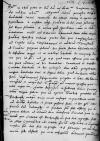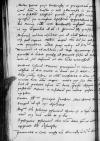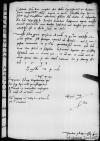Veni ⌊Warmiam⌋ die octava Martii et exivi ex ⌊Pyotrkovia⌋ 2 eiusdem mensis. ⌊Conventus⌋ nondum erat solutus, sed brevi solvetur et melius, quam sperabatur, omnia in eodem concludentur. Omnes enim articulos confirmavit sacra ⌊maiestas regia⌋ hominibus equestris ordinis praeter duos, quos transposuit cum consilio dominorum consiliariorum et nuntiorum terrestrium ad conventum proxime futurum.
Hoc finito statim consultabant de defensione ⌊Regni⌋ et, ut intellexi, contribuant de unoquoque laneo per 18 grossos, vel per 24, quod magis affirmo, quia maior pars nuntiorum ad hoc ten{te}debat. Exactiones et ducill<i>a civitates contribuant et haec in duplo dare debent. Propterea magna contributio dari et componi debet, quod duodecim milia hominum stipend<i>ariorum susciperentur propter et contra ⌊Moldavum⌋ corrigendum et corripiendum etc., propter tam magnos excessus, quos intulit ⌊regno⌋ etc.
Finita defensione in iudiciis debuit sacra ⌊maiestas regia⌋ sedere. ⌊Quae⌋ iam optime convaluit. Portatur enim ⌊Biechowski⌋, antequam terminus venit, aufugit ex ⌊Pyotrkovia⌋ nocte cum nonnullis complicibus et sociis pessimis facti, et hoc propter interfectionem domini ⌊Lubranski⌋. Et quattuor sunt fide obstricti, qui comparere debent ad ultimum diem conclusionis ⌊conventus⌋ nam et eodem ... designatus est dies Biechowski, quia in citatione, qua citatus est ⌊Biechowski⌋, non fuit dies expressa, sed in aliis citationibus, ubi citati fuerunt adhaerentes et complices eiusdem facti, dies fuit expressa 28 Februarii. Qui tunc comparuerunt, fide obstricti, qui vero aufugerunt, contumaces pronuntiati.
Multos habuit pro se ⌊Biechowski⌋, et praecipuos: dominum ⌊palatinum Cracoviensem⌋, ⌊dominos a Lasko⌋ et dominum ⌊Odrowąsch⌋ etc. ⌊Qui⌋ magna[m] et inaudibilem diligentiam fecerunt, quomodo posset evadere ... excessum. ⌊Qui⌋ in crastino discesserunt ex ⌊Pyotrkovia⌋ hoc est pri[ma] die Martii. Eadem nocte ⌊Biechowszki⌋ in fugam conversus et vix comparebit ad diem et terminum sibi praefixum.
⌊Moscorum⌋ nuntius absolutus, qui nil aliud habuit in legatione, nisi quod rogavit ⌊maiestatem regiam⌋ nomine ⌊domini sui⌋, quod sua maiestas permitteret nuntios ducis Moscorum ad serenissimum ⌊regem Romanorum⌋ et ad ⌊Moldavum⌋. Ad ⌊regem Romanorum⌋ sunt permissi et conducti quousque ad granicies ⌊Slesiae⌋, ad ⌊Moldavu[m]⌋ vero non, sed ⌊Moscoviam⌋ cum alio nuntio retrocesserunt.
Oratores caesarum Tartariae ⌊Precopiensis⌋ et ⌊Cosanensis⌋ sunt absoluti et bene tractati et donati. Qui se obtulerunt nomine dominorum suorum ⌊caesarum⌋ ad omnes necessitates et contra omnes inimicos sacrae ⌊maiestatis regiae⌋. Mittit etiam ⌊sua maiestas⌋ nuntios suos ad praedictos ⌊caesares⌋ cum donis propter obsequia, quae praestiterunt ⌊Moscoviae⌋, et in futurum, quae volunt praestare et exhibere.
Orator illustrissimi principis ⌊Ioachimi marchionis Brande[n]burgensis⌋ iam est etiam absolutus.
Magnificus dominus ⌊palatinus Posnaniensis⌋ electus est in episcopum Wladislaviensem. Cuius ⌊⌋ mitto Reverendissimae Paternitati Vestrae. Episcopatus Posnaniensis adhuc nemini datus. Quem, ut intellexi, exspectat dominus ⌊Olesniczki⌋.
Pincernatus curiae acceptus domino ⌊Sborowski⌋ nondum est alicui da[tus].
Celebratae sunt binae nuptiae die Dominico Carnisprivii in aula sacrae ⌊reginalis maiestatis⌋. Duxit in uxorem illustris dux ⌊Helias⌋ filius ducis ⌊Constantini Ostroviensis⌋ ⌊filiam⌋ domini ⌊Andreae de Cosczielecz⌋. Et dominus ⌊Vyrschelo⌋ incisor ⌊Ducatus Lithuaniae⌋ duxit virginem Mariam procreatam ex ducibus Lithuaniae vel Russiae, quae etiam educata est in aula sacrae ⌊reginalis maiestatis⌋.
Venissem solus propria persona ad Vestram Reverendissimam Paternitatem et ea retulissem et alia plura, sed fatiga equorum non admisit, tamen si me postea vocaverit Reverendissima Paternitas Vestra, paratus sum venire.
Quam Dominus Deus diu felicem et sospitem conservare dignetur pro singulari consolatione mea et domus meae. Et iam me et omnia mea commendo gratiae Reverendissimae Paternitatis Vestrae.



